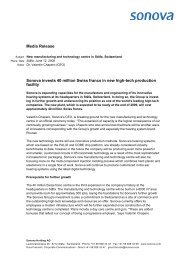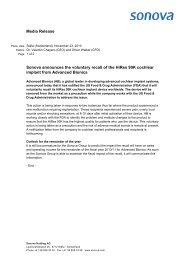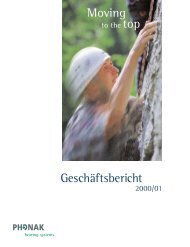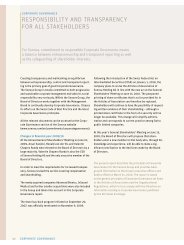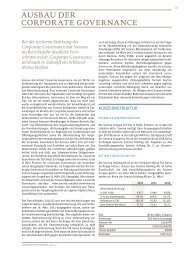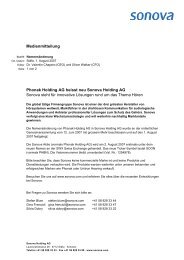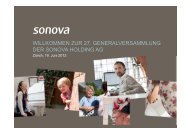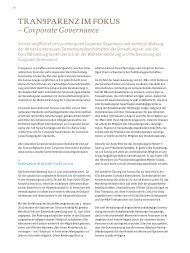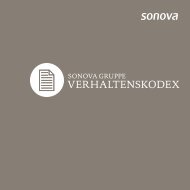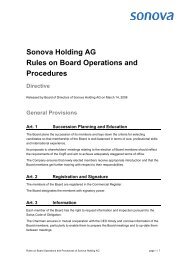Annual Report 2010/11 - Sonova
Annual Report 2010/11 - Sonova
Annual Report 2010/11 - Sonova
You also want an ePaper? Increase the reach of your titles
YUMPU automatically turns print PDFs into web optimized ePapers that Google loves.
3. Basis of consolidated<br />
financial statements<br />
The consolidated financial statements of the Group are<br />
based on the financial statements of the in dividual Group<br />
Companies at March 31 prepared in accordance with<br />
uniform accounting policies. The consolidated financial<br />
statements have been prepared under the historical cost<br />
convention except for the revaluation of certain financial<br />
assets at market val ue, in accordance with International<br />
Financial <strong>Report</strong>ing Standards (IFRS), including International<br />
Accounting Standards and Interpretations issued by<br />
the International Accounting Standards Board (IASB). The<br />
consolidated financial statements were approved by the<br />
Board of directors of <strong>Sonova</strong> Holding AG on May 10, 20<strong>11</strong><br />
and are subject to approval by the <strong>Annual</strong> General Shareholders’<br />
Meeting on June 21, 20<strong>11</strong>.<br />
The consolidated financial statements include <strong>Sonova</strong><br />
Holding AG as well as the domestic and foreign subsidiaries<br />
over which <strong>Sonova</strong> Holding AG exercises control. A<br />
list of the significant com panies which are consolidated is<br />
given in Note 36.<br />
The preparation of financial statements requires management<br />
to make estimates and assumptions that affect the<br />
amounts reported for assets and liabilities and contingent<br />
assets and liabilities at the date of the financial statements<br />
as well as revenue and expenses reported for the financial<br />
year (refer also to Note 3.6, “Significant accounting judgements<br />
and estimates”). Actual results could differ from these<br />
estimates.<br />
3.1 Principles of consolidation<br />
INveSTMeNTS IN SuBSIdIARIeS<br />
Investments in subsidiaries are fully consolidated. These<br />
are entities over which <strong>Sonova</strong> Holding AG directly or<br />
indirectly exercises control. Control is the power to govern<br />
the financial and operating poli cies of an entity so as to<br />
obtain benefits from its ac tivities. Control is presumed to<br />
exist when the parent owns, directly or indirectly through<br />
subsidiar ies, more than half of the voting power of an entity<br />
unless, in exceptional circumstances, it can be clearly<br />
demonstrated that such ownership does not constitute<br />
control. For the consolidated entities, 100% of assets,<br />
liabilities, income, and expenses are included. Noncontrolling<br />
interests in equity and net income or loss are<br />
shown separately in the balance sheet and income statement.<br />
Changes in the ownership interest of a subsidiary<br />
that does not result in a loss of control will be accounted<br />
CoNSoLIdATed FINANCIAL STATeMeNTS<br />
for as an equity transaction. Neither goodwill nor any<br />
gains or losses will result.<br />
Group Companies acquired during the year are included in<br />
the consolidation from the date on which control over the<br />
company is transferred to the Group, and are excluded from<br />
the consolidation as of the date the Group ceases to have<br />
control over the company. Intercompany balances and transactions<br />
(incl. unrealized profit on intercompany in ventories)<br />
are eliminated in full.<br />
INveSTMeNTS IN ASSoCIATeS<br />
Investments in associates are accounted for using the<br />
equity method of accounting. These are entities in which<br />
<strong>Sonova</strong> has significant influence and which are neither<br />
subsidiaries nor joint ventures of <strong>Sonova</strong>. Significant influence<br />
is the power to par ticipate in the financial and operating<br />
policy decisions of the acquired company but is not<br />
control or joint control over those policies (usually 20–50%<br />
of voting rights). under the equity method, the investment<br />
in an associate is initially recognized at cost (including<br />
goodwill on acqui sition) and the carrying amount is increased<br />
or decreased to recognize <strong>Sonova</strong>’s share of profit or loss<br />
of the acquired company after the acquisition date. In order<br />
to apply the equity method the most recent available financial<br />
statements of an associate are used, however due to<br />
practicability reasons the reporting dates might vary up to<br />
three months from the Group’s reporting date. The net<br />
assets and results from associates are adjusted, if necessary,<br />
to comply with the Group’s accounting policies.<br />
The Group’s share of equity in associated com panies, consolidated<br />
using the equity method, is shown in the balance<br />
sheet as “Investments in associates/joint ventures,” and<br />
its share of the re sults of operations for the year is shown in<br />
the income statement as “Share of gain/loss in asso ciates/<br />
joint ventures.”<br />
Associates acquired during the year are accounted for as<br />
“Investments in associates/joint ventures” from the date on<br />
which significant influence over the acquired company is<br />
transferred to the Group, and derecognized from that position<br />
as of the date the Group ceases to have significant<br />
influence over an associate.<br />
97




